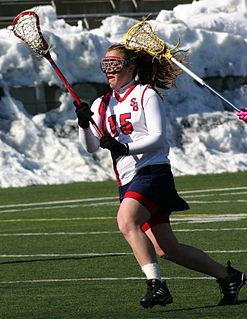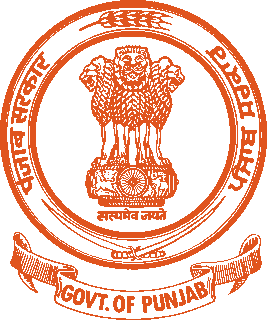
Field hockey is a team sport of the hockey family. Each team plays with ten field players and a goalkeeper, and must carry a round, hard, plastic hockey ball with a hockey stick to the rival goal.

Gaelic football, commonly referred to as football, Gaelic or GAA, is an Irish team sport. It is played between two teams of 15 players on a rectangular grass pitch. The objective of the sport is to score by kicking or punching the ball into the other team's goals or between two upright posts above the goals and over a crossbar 2.5 metres above the ground.
In many team sports which involve scoring goals, the goalkeeper is a designated player charged with directly preventing the opposing team from scoring by blocking or intercepting opposing shots on goal. Such positions exist in bandy, rink bandy, camogie, association football, Gaelic football, international rules football, floorball, handball, hurling, field hockey, ice hockey, roller hockey, lacrosse, ringette, rinkball, water polo, and shinty as well as in other sports.

A face-off is the method used to begin and restart play after goals in some sports using sticks, primarily ice hockey, bandy and lacrosse. The two teams line up in opposition to each other, and the opposing players attempt to gain control of the puck or ball after it is dropped or otherwise placed between their sticks by an official.

Women's lacrosse, sometimes shortened to lax, is a sport with twelve players on the field at a time. Originally played by indigenous peoples of the Americas, the modern women's game was introduced in 1890 at the St Leonard's School in St Andrews, Scotland. The rules of women's lacrosse differ significantly from men's field lacrosse. The two are often considered to be different sports with a common root.

Shuffleboard, more precisely deck shuffleboard, and also known as floor shuffleboard, is a game in which players use cues to push weighted discs, sending them gliding down a narrow court, with the purpose of having them come to rest within a marked scoring area. As a more generic term, it refers to the family of shuffleboard-variant games as a whole.

Field lacrosse is a full contact outdoor men's sport played with ten players on each team. The sport originated among Native Americans, and the modern rules of field lacrosse were initially codified by Canadian William George Beers in 1867. Field lacrosse is one of three major versions of lacrosse played internationally. The rules of men's lacrosse differ significantly from women's field lacrosse. The two are often considered to be different sports with a common root. Another version, box lacrosse is also played under different rules.

Yut Nori, also known as Yunnori, Nyout, and Yoot, is a traditional board game played in Korea, especially during Korean New Year. The game is also called cheok-sa or sa-hee. The combining-form -nori means 'game'.

An analog stick, sometimes called a control stick or thumbstick, is an input device for a controller that is used for two-dimensional input. An analog stick is a variation of a joystick, consisting of a protrusion from the controller; input is based on the position of this protrusion in relation to the default "center" position. While digital sticks rely on single electrical connections for movement, analog sticks use continuous electrical activity running through potentiometers to measure the exact position of the stick within its full range of motion. The analog stick has greatly overtaken the D-pad in both prominence and usage in console video games.

Handgame, also known as stickgame, is a Native American guessing game, in which marked "bones" are concealed in the hands of one team while another team guesses their location.
Tippit is a Welsh game played with a single coin, that dates back hundreds of years. Similar games - including Up Jenkins - are played elsewhere in Europe and the United States.

Morra is a hand game that dates back thousands of years to ancient Roman and Greek times. Each player simultaneously reveals their hand, extending any number of fingers, and calls out a number. Any player who successfully guesses the total number of fingers revealed by all players combined scores a point.
This is a list of common terms used in ice hockey along with the definition of these terms.
Traditional Filipino games or indigenous games in the Philippines are games commonly played by children, usually using native materials or instruments. In the Philippines, due to limited resources for toys, Filipino children usually invent games without needing anything but the players themselves. Their games' complexity arises from their flexibility of thought and action.

Slahal is a gambling game of the indigenous peoples of the Pacific Northwest Coast, also known as stickgame, bonegame, bloodless war game, handgame, or a name specific to each language. It is played throughout the western United States and Canada by indigenous peoples. Traditionally, the game uses the shin bones from the foreleg of a deer or other animal. The name of the game is a Chinook Jargon word.
Jereed is a traditional Turkish equestrian team sport played outdoors on horseback in which the objective is to score points by throwing a blunt wooden javelin at opposing team's horsemen. Played by Turkic peoples in Central Asia as the essential sporting and ceremonial game, it was brought to Anatolia during the westward migration in the beginning of the 11th century.
Traditional games of Andra Pradesh, like many traditional games played in India, involve games which are played mostly by children. These games may also be enjoyed by other people of any age, as it reminds them of their childhood. Despite the advent of computers and technology, with children preferring to spend their times indoors, these games are still very popular in the Andhra Pradesh. They are also played in great and small towns all over India and Pakistan especially in Andhra Pradesh, Tamil Nadu, Punjab, as well as Cambodia and Italy..
Kah is an Apache game described by Geronimo in his 1906 autobiography as told to S. M. Barrett. The game was always played at night, after a feast and dancing were held to celebrate some notable event. It usually involved gambling and was the most popular gambling game among the Apaches.

Indigenous North American stickball is considered to be one of the oldest team sports in North America. Stickball and lacrosse are similar to one another, the game of lacrosse is a tradition belonging to tribes of the Northern United States and Canada; stickball, on the other hand, continues in Oklahoma and parts of the Southeastern U.S. where the game originated. Although the first recorded writing on the topic of stickball was not until the mid-17th century, there is evidence that the game had been developed and played hundreds of years before that.

Punjabis play a wide variety of sports and games, ranging from modern games such as hockey and cricket, to the more traditional games such as Kabaddi, Kushtian (wrestling) and Khuddo khoondi. There are over 100 traditional games and sports of Punjab.













